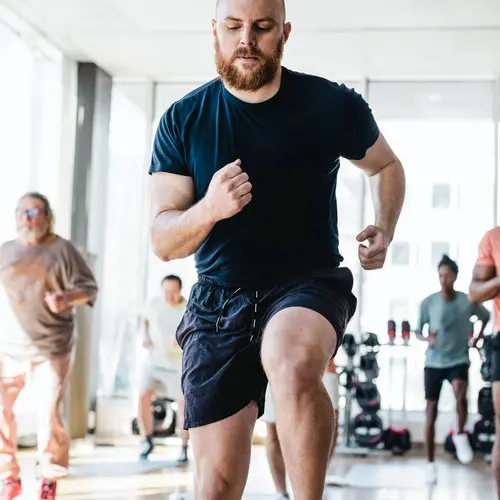Trampolines are a great way for adults and kids to have fun and exercise, but it can also lead to injury. Trampolining improves coordination between various body parts. This article looks at how to choose the best trampoline for your family, some of the benefits and risks of jumping on the trampoline, and effective trampoline exercises.
What Are Trampolines?
A trampoline is a metal frame that holds a tense fabric The fabric is stretched and attached to the metal frame at the periphery with the help of coiled springs. These springs give trampolines their characteristic bounce.
Smaller trampolines typically limit your movement to jumping, while larger ones allow you to tumble and fall. Trampolining is also a recreational and acrobatic sport, and some movements require a lot of skill.
How to Choose a Trampoline?
Consider some of the following points when you’re choosing a trampoline.
- Who’s going to use it? One of the first things you’ll need to determine is who will use the trampoline. If you’re mainly buying it for your kids, make sure it has adequate safety features.
- Size and space. Trampolines are available in several sizes. You can choose one depending on where you’re going to keep it and how many people will use it at the same time. Keep trampolines on a level surface, and the area around the trampoline should be free of injury hazards such as debris or other materials. Trampoline injuries commonly occur when people enter or leave the trampoline. If you keep the trampoline outdoors, protect it from rain and snowfall, or you may need to assemble and disassemble it often.
- Safety. When choosing a trampoline, safety should be your primary concern. Check whether the trampoline comes with features like safety pads on the metal frames and springs. Netting is essential to prevent falling off of the trampoline. Having a ladder helps people get onto the trampoline easily. Turn the paddings over at regular intervals to prevent wear and tear and limit sun exposure on each side.
- Assembly. Assembling a trampoline could be a fun activity to do with the kids. Manufacturers also offer installation, but some may ask for an additional fee for this service.
How to Use a Trampoline for Exercise?
Exercising on the trampoline is known as “rebounding,” as you use the elastic nature of the trampoline fabric to rebound after a jump or a tumble. Here are a few common trampoline exercises:
- Hopping. If you’re a beginner, you can start with the simplest movement. Jump on the trampoline and press into the fabric with your feet together.
- Knee jumps. To do knee jumps on the trampoline, bend your right knee while you're in the air and touch it with your right hand. In the next jump, lift your left knee and touch it with your left hand.
- Jumping jacks. Jumping jacks on a trampoline are a lot like jumping jacks on the ground. Begin by jumping normally and, while in the air, spread your feet apart while swinging your arms out to the side and overhead. As you come back down, your feet will be apart. On the next jump, bring your feet back together and put your arms by your side.
- Twist. Jump and twist your body to one side and, in the next jump, turn it to the other side.
Benefits of Trampoline Exercises
While some just jump on the trampoline for fun, others do it for their health. Here are some benefits to jumping on a trampoline:
- Increased strength. Jumping on the trampoline engages several muscle groups. As you use your body’s momentum to move on the trampoline, you stimulate the muscles in your glutes, legs, back, and abdomen to help you jump. Over time, this can increase strength.
- Improved cardiovascular health. Jumping up and down repeatedly works your heart, pumps blood throughout your body, and improves aerobic capabilities. This is especially helpful for athletes participating in distance swimming and marathons.
- Enhanced balance. If you’re beginning to jump on the trampoline, you’re more likely to move around its surface as you land on it. Different points on the trampoline yield differently when you press on them, so you’ll have to balance yourself accordingly to get enough thrust on your next jump. Consistently doing this improves your balance and strengthens your core muscles.
- Low impact. There’s increasing awareness about the impact of exercise on your body. For example, when you run on hard surfaces, you put a lot of stress on specific joints such as your knees and ankles, which, over time, can lead to chronic injuries. Trampolining is a low-impact exercise that works several joints without placing undue stress on them, thus reducing the likelihood of chronic injuries.
- Calorie loss. Research suggests rebounding can be three times more effective at burning calories when compared to other exercises, like running.
- Reduced stress. Exercise releases endorphins that reduce stress. When you’re rebounding, you alternately tense and relax your muscles, which improves circulation and has a distinct impact on your body. Once you finish rebounding, the muscles relax, bringing a feeling of relaxation that can help relieve stress.
Are Trampolines Safe?
Trampolines can cause serious injuries such as broken bones, concussions, sprains, bruises, and head injuries. Statistics from the U.S. Consumer Product Safety Commission reported more than 300,000 injuries due to trampolines in 2018, out of which over 110,000 needed emergency medical attention. Most trampoline injuries occurred at home trampolines, but those at jump parks caused the most serious injuries.
To prevent injuries, make sure only one person uses the trampoline at a time and avoid attempting high-risk movements without proper training and safety precautions.


